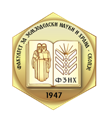CHANGES IN LEAF COLOR AND RELATIVE WATER CAPACITY OF LETTUCE (Lactuca sativa L.) DEPENDING ON THE USE OF THE SHADING NET
Keywords:
lettuce, shading net, color, RWCAbstract
Lettuce leaf color is a hereditary trait, and among environmental factors, light/radiation and temperature are the two most influential climatic variables. This research is based on the effect of the application of photoselective nets of different densities, that is, with different percentages of shading, on leaf coloration and relative water content (RWC) at lettuce maturation. Three nets with different shading percentages were used, namely green nets with a shade of 50% and 35% and one white net with a shade of 50%, and plants without shading were used as controls. To determine the full effect of the application of nets on the production of summer lettuce, the experiment was conducted in two planting periods: May-June and September-October 2021 with lettuce Zeralda F1 and Abbice F1 in the greenhouse. Colorimetry was performed on three occasions, every seven days, and in the phase when 70% and 80% of the plant mass was reached. Regarding the color of the leaves, it was shown that in the second period of cultivation at the end of the vegetation, a difference in the intensity of the color was found, that is, the net with stronger shading (G50) showed a stronger intensity of lettuce color compared to the other tested variants. RWC was quite different depending on the variant in the first growing period, while in the second growing period, the highest was in the control plants (89.48%) and those under nets with 50% shade (77.69%).



